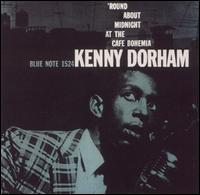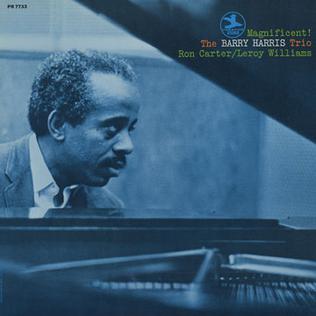Related Research Articles
"Hot House" is a bebop standard, composed by American jazz musician Tadd Dameron in 1945. Its harmonic structure is identical to Cole Porter's "What Is This Thing Called Love?". The tune was made famous by Dizzy Gillespie and Charlie Parker as a quintet arrangement and become synonymous with those musicians; "Hot House" became an anthem of the bebop movement in American jazz. The most famous and referred to recording of the tune is by Parker and Gillespie on the May 1953 live concert recording entitled Jazz at Massey Hall, after previously recording it for Savoy records in 1945 and at Carnegie Hall in 1947. The tune continues to be a favorite among jazz musicians and enthusiasts:
"What Is This Thing Called Love?" is a 1929 popular song written by Cole Porter, for the musical Wake Up and Dream. It was originally published by Harms and first performed by Elsie Carlisle in March 1929. The song has become a popular jazz standard and one of Porter's most often played compositions.

Barry Doyle Harris was an American jazz pianist, bandleader, composer, arranger, and educator. He was an exponent of the bebop style. Influenced by Thelonious Monk and Bud Powell, Harris in turn influenced and mentored bebop musicians including Donald Byrd, Paul Chambers, Curtis Fuller, Joe Henderson, Charles McPherson, and Michael Weiss.

"(Back Home Again in) Indiana" is a song composed by James F. Hanley with lyrics by Ballard MacDonald that was published in January 1917.
A contrafact is a musical work based on a prior work. The term comes from classical music and has only since the 1940s been applied to jazz, where it is still not standard. In classical music, contrafacts have been used as early as the parody mass and In Nomine of the 16th century. More recently, Cheap Imitation (1969) by John Cage was produced by systematically changing notes from the melody line of Socrate by Erik Satie using chance procedures.
"Oleo" is a hard bop composition by Sonny Rollins, written in 1954. It has become a jazz standard, and has been performed by numerous jazz artists such as Miles Davis, John Coltrane, and Bill Evans.
William Allen Mays, known professionally as Bill Mays, is an American jazz pianist from Sacramento, California.

Sylvester Kyner Jr., known as Sonny Red, was an American jazz alto saxophonist and composer associated with the hard bop idiom among other styles.

Gary Smulyan is an Amercian jazz musician who plays baritone saxophone. He studied at Hofstra University before working with Woody Herman. He leads a trio with bassist Ray Drummond and drummer Kenny Washington.

Straight Life is an album by the American saxophonist Art Pepper, released in 1979. Pepper was joined by Tommy Flanagan, Red Mitchell, Billy Higgins and Kenneth Nash.
"Groovin' High" is an influential 1945 song by jazz composer and trumpeter Dizzy Gillespie. The song was a bebop mainstay that became a jazz standard, one of Gillespie's best known hits, and according to Bebop: The Music and Its Players author Thomas Owens, "the first famous bebop recording". The song is a complex musical arrangement based on the chord structure of the 1920 standard originally recorded by Paul Whiteman, "Whispering", with lyrics by John Schonberger and Richard Coburn (né Frank Reginald DeLong; 1886–1952) and music by Vincent Rose. The biography Dizzy characterizes the song as "a pleasant medium-tempo tune" that "demonstrates...[Gillespie's] skill in fashioning interesting textures using only six instruments".

Jazz Message #2 is an album by jazz saxophonist Hank Mobley released on the Savoy label in 1957. It was recorded on July 23 & November 7, 1956 and features performances by Mobley, Donald Byrd, Lee Morgan, Hank Jones, Doug Watkins Barry Harris, Kenny Clarke and Art Taylor. Lee Morgan was very young in this recording.

'Round About Midnight at the Cafe Bohemia is a live album by American jazz trumpeter Kenny Dorham recorded at the Café Bohemia on May 31, 1956 and released on Blue Note later that year.
"Ah-Leu-Cha" is a bebop composition written in 1948 by American jazz saxophonist Charlie Parker. It is a contrafact of "Honeysuckle Rose" in the "A" section and "I Got Rhythm" in the "B" section. "Ah-Leu-Cha" was originally recorded by Charlie Parker All-Stars on September 18, 1948, in New York City for Savoy Records.
"Constellation" is a bebop composition written in 1948 by American jazz saxophonist Charlie Parker. It is a contrafact of "I Got Rhythm". "Constellation" was originally recorded by the Charlie Parker All-Stars on September 18, 1948 in New York City for Savoy Records.
"Lady Bird" is a sixteen-bar jazz standard by Tadd Dameron. This "celebrated" composition, "one of the most performed in modern jazz", was written around 1939, and released in 1948. Featuring, "a suave, mellow theme," it is the origin of the Tadd Dameron turnaround (in C: CM7 E♭7 A♭M7 D♭7 CM7).

Magnificent! is an album by pianist Barry Harris recorded in 1969 and released on the Prestige label.
"26-2" is a musical composition written by American jazz musician John Coltrane. The song was recorded by Coltrane in 1960, but it released ten years later by Atlantic Records on an album entitled The Coltrane Legacy with a rhythm section composed of McCoy Tyner on piano, Steve Davis on bass, and Elvin Jones on drums. The composition itself is a contrafact of Charlie Parker's tune "Confirmation", with harmonic alterations to the original chord changes used by Coltrane in a number of his compositions. This harmonic modification is commonly known as Coltrane Changes, which have been most notably used in Coltrane's "Giant Steps". "26-2" is one of several contrafacts by Coltrane, others including "Countdown", a contrafact of Miles Davis's "Tune Up"; and "Satellite" from the album Coltrane's Sound, which is based upon the chord progression of "How High the Moon". Coltrane plays the first statement of the melody on tenor saxophone and switches to soprano saxophone for the last statement of the melody on the recorded version.

Inscape–Tableaux is an album by bassist Barry Guy. It was recorded on May 18 and 19, 2000, at Rote Fabrik in Zürich, Switzerland, and was released in 2001 by Intakt Records. On the album, which features a seven-part composition by Guy, he plays bass and directs members of his New Orchestra: Evan Parker and Mats Gustafsson on saxophone, Hans Koch on saxophone and clarinet, Herb Robertson on trumpet, Johannes Bauer on trombone, Per Åke Holmlander on tuba, Marilyn Crispell on piano, and Paul Lytton and Raymond Strid on percussion.
References
- ↑ Levine, Mark (2011). The Jazz Theory Book. O'Reilly Media, Inc. p. 416. ISBN 9781457101458 . Retrieved 8 April 2012.
- ↑ Todd, Jim. "Magnificent". AllMusic. Retrieved 29 October 2018.
- ↑ Dryden, Ken. "Bicks Bag - Bill Mays, Neil Swainson, Terry Clarke Trio". AllMusic. Retrieved 3 July 2018.